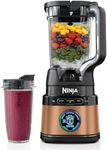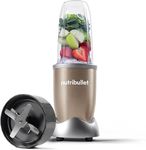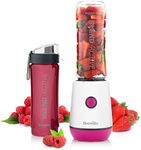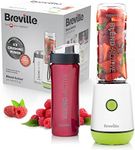Buying Guide for the Best Smoothie Blenders
Choosing the right smoothie blender can make a big difference in your daily routine, especially if you enjoy making smoothies regularly. The right blender will help you achieve the perfect texture and consistency for your smoothies, and it can also be versatile enough to handle other kitchen tasks. When selecting a smoothie blender, consider the following key specifications to ensure you get the best fit for your needs.Power (Wattage)Power, measured in watts, determines how effectively a blender can crush and blend ingredients. Higher wattage means more power, which is essential for blending tough ingredients like ice, frozen fruits, and fibrous vegetables. Blenders typically range from 200 to 1500 watts. For basic smoothies with soft fruits, a blender with 200-500 watts may suffice. For more versatility and the ability to handle tougher ingredients, look for a blender with 600-1000 watts. If you plan to use your blender for more demanding tasks like crushing ice or making nut butter, consider models with 1000 watts or more.
CapacityCapacity refers to the volume of the blender jar, usually measured in liters or ounces. This is important because it determines how much smoothie you can make in one go. Blender jars typically range from 0.5 liters (16 ounces) to 2 liters (64 ounces) or more. If you’re making smoothies for one or two people, a smaller capacity (0.5-1 liter) should be sufficient. For larger families or if you like to make big batches, look for a blender with a capacity of 1.5 liters or more. Consider your typical usage and choose a capacity that matches your needs.
Blade Material and DesignThe blades are crucial for blending efficiency. Most blender blades are made from stainless steel, which is durable and resistant to rust. The design of the blades can also affect performance. Some blenders have multi-tiered blades or specially angled blades to enhance blending efficiency. When choosing a blender, look for high-quality stainless steel blades and consider the design. If you plan to blend tough ingredients, opt for blenders with robust, well-designed blades that can handle the task without dulling quickly.
Speed SettingsSpeed settings allow you to control the blending process. Blenders can have anywhere from one to ten or more speed settings, plus pulse functions. More speed settings provide greater control over the texture of your smoothie. For basic smoothies, a blender with 2-3 speed settings may be enough. If you want more control for different recipes, look for blenders with multiple speed options and a pulse function. Consider what you’ll be blending and how much control you want over the process.
Ease of CleaningCleaning your blender can be a hassle, so ease of cleaning is an important factor. Some blenders have dishwasher-safe parts, which can save time and effort. Others have self-cleaning functions where you add water and a bit of dish soap, then run the blender to clean it. When choosing a blender, consider how easy it will be to clean after use. Look for models with removable blades and dishwasher-safe components if convenience is a priority for you.
Noise LevelBlenders can be quite noisy, which can be a concern if you’re blending early in the morning or late at night. Noise levels can vary significantly between models. Some blenders are designed with noise reduction features to minimize disruption. If noise is a concern for you, look for blenders that are specifically marketed as quiet or have noise-dampening features. Reading user reviews can also give you an idea of how loud a blender is in real-world use.
Durability and WarrantyDurability is important because you want your blender to last. Look for blenders made with high-quality materials and solid construction. A good warranty can also provide peace of mind. Warranties can range from one year to several years, depending on the brand and model. When choosing a blender, consider the build quality and the length and terms of the warranty. A longer warranty often indicates a manufacturer’s confidence in their product’s durability.














